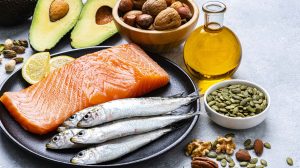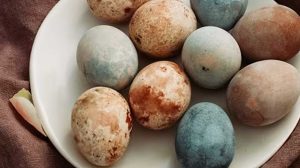Salt is a big part of the average American’s daily life. So much so that we expect to find it on every restaurant table and as an ingredient in many premade meals. In fact, it’s so ubiquitous that it’s one of the few ingredients that HelloFresh doesn’t send along with its dinner recipes.
The word itself comes from the Latin word sal. And speaking of words, the English word salary is derived from the word salt—those little granules were once considered so valuable that they were used as a trading currency.
But what are the different types of salt? Do you use the same types of salt for cooking as you do for brining? What’s the point of having different types of salt on hand?READERS EXCLUSIVE: Get 16 Free Meals + First Box Ships Free + a Free Breakfast Item for Life
Types of Salt for Cooking and Their Best Uses
Salt comes down to science, and the way a given salt is formed can dictate its size, flavor, best uses, and even price. It’s rare that substituting one salt for another would destroy a dish. But using the right salt for the right purpose can elevate the food into something more than the sum of its parts.
Best Uses for Table Salt
Table salt is the granulated, slippery white salt you’ll find at most eating establishments and kitchen tables. We get table salt when the chlorine and sodium atoms of salt are packed tightly. Table salt is generally mined from underground deposits, then processed to remove unwanted minerals and fortified with additives so it won’t clump. One of these additives is iodine (hence the term iodized), which encourages thyroid health.
You can use table salt for cooking, as it’s inexpensive and easy to find. The tightly packed granules of table salt make it great for baking—when you’re meting out a specific amount onto a measuring spoon, table salt is more likely to stay true to its measurement.
Best Uses for Kosher Salt
When the salt crystals are more open than they are with table salt, we get the lighter kosher salt. While any salt is kosher due to it being just a mineral compound, the term kosher salt means a large-grained salt originally used for pulling blood out of meat during the koshering process.
Kosher salt is also popular for cooking. Why cook with kosher salt? First, you have more control over where it goes due to its flakier texture—if you sprinkle it over a finished dish, you’re more likely to sprinkle it evenly rather than having the slippery granules of table salt escape your grip all at once. And kosher salt is pure, so it’s not iodized like table salt, meaning you won’t get the metallic or bitter flavor table salt can have.
Best Uses for Sea Salt
Sea salt is created when seawater evaporates. The final product varies as enormously as the seas themselves—you can find sea salt that’s gray, pink, or white; flaked, chunked, or pearled.
You can use sea salt for cooking, even in place of kosher salt if you like, as they have a similar composition. But sea salt is generally used as a finishing salt sprinkled on top before eating, due to it being one of the pricier salts on the market.
Best Uses for Fleur De Sel Salt
Fleur de sel means “flower of salt,” and this rare, briny-tasting twin sibling of sea salt is found in parts of France. It’s made with the thin salt layer on top of seawater pools on the coast of France, mostly in the region of Brittany. It forms only with specific weather conditions and must be skimmed by hand.
While cooking with fleur de sel is possible, it is pricey, so you’re better off using it as a sprinkle before eating. Its high moisture content means the crystals stick together more on your tongue, so your experience of it might be a little intense.
Best Uses for Pink Salt
Himalayan pink salt is sourced near the Himalayan mountains in South Asia as a healthy alternative to regular salt, since it contains about one-third less sodium than table salt. It can have trace amounts of minerals not found in table salt, such as zinc and potassium, though it doesn’t contain enough to necessarily benefit your health.
Himalayan pink salt can be great for cooking, though it’s more expensive than table salt and kosher salt. And it has a particularly fun cooking use: Blocks of the stuff can be used as a cooking surface or even a serving platter. The tightly packed slabs retain heat well, resulting in an even finish to your cooked foods, and used as a platter, it makes for a memorable bit of décor.
Types of Brining Salt
Brining is a method for adding moisture and flavor to chicken, pork, seafood, and turkey to make sure the texture doesn’t dry out in the cooking process. Generally you’ll be soaking your meat in heavily salted water overnight before cooking. The meat absorbs the water, and a good brining can decrease moisture loss in cooking by up to 40%. Here are some salts you can use in the brining process.
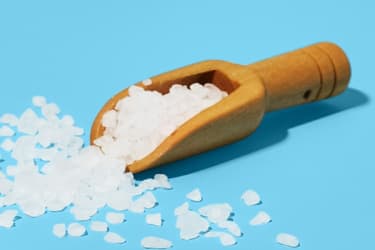
Kosher Salt for Brining
Kosher salt is a top choice for brining because it has large flakes, dissolves easily, and sticks to food well. It’s an excellent option for brining a turkey.
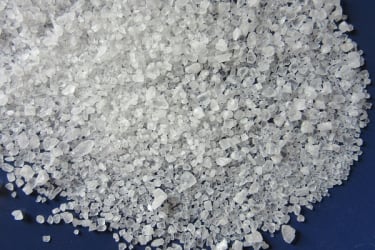
Sea Salt for Brining
Sea salt is another good brining option, though it might add its own flavor to the brine. And since it’s on the costly side, you might not want to waste it when you can use something like kosher salt.
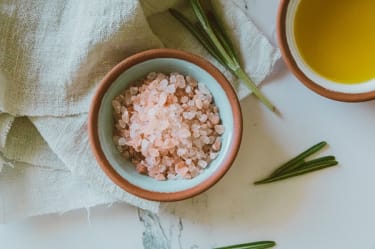
Himalayan Pink Salt for Brining
Himalayan pink salt can also be used for brining, but like sea salt it adds its own flavor and is on the pricier side. Your best best for brining is the more affordable kosher salt.



